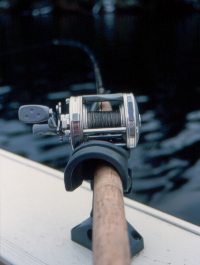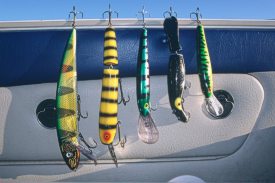Deep Trolling for Musky By Tim
Allard

Trolling for musky is a productive tactic throughout
the season, but it is in the fall when this method lives up to its
reputation: big musky! As water bodies cool and fish put on the feed
bag, trolling deep-diving crankbaits is an excellent technique for
increasing your chances of landing a trophy. Understanding fall
musky behavior, using a strategy to target deep fish, and having
proper equipment are three critical components to fall fishing
success.
FALL MUSKY TRANSITION
First, in large bodies of water from post-spawn to late summer, let
us divide musky into two categories: shallow and deep fish. Granted,
separating musky location into two extremes is a simplification, but
it will help explain the fall transition. Shallow fish inhabit
depths to 15 feet, occupying structures like weedy bays and points.
The other fish relate to deep structure, like rocky reefs, and feed
on baitfish, such as cisco, in open water.
Fall trolling is productive because many fish move from shallow,
summer haunts to deeper water. One reason the change occurs is that
decaying vegetation no longer produces oxygen or provides shelter,
reducing its ability to hold forage. This results in fish abandoning
shallow, weedy structure and relating with the breakline, rocky
structure and open water baitfish. Recognizing this change of
shallow musky behavior and adjusting your fishing strategy will
increase your fall catch percentage. Deep-diving crankbaits are
perfect for fishing the fall transition.
TECHNIQUE
Trolling crankbaits deep is a different method than running shallow
baits over deep water. The former is this article's focus, although
the latter can be a deadly technique as well. How deep you run your
baits will depend on the structure you are fishing and where you
have marked musky or baitfish. 20 feet is a good start and getting
down to 30 feet or more can be productive over deep water.
The depth your baits will run is influenced by: the design of the
bait itself, the speed of your troll, the amount of line out, and
the line's diameter and resistance. Knowing the bait's running depth
when trolling is critical, particularly when you have marked fish at
a particular depth. Troll baits a few feet above these fish, as
musky are more likely to rise to hit a trolled lure then dive to
one.
One way to determine a crankbait's running depth is moving
progressively shallower at your anticipated trolling speed, usually
between one to four miles per hour in the fall. Next, test your lure
at boat side, ensuring it is running properly and adjust if
required. Let out line and monitor the depth while trolling
shallower until your crankbait begins to hit bottom. This method
provides the bait's general running depth. If not deep enough let
out more line, increase speed, angle the rod tip higher, or change
baits. Now that you know your bait's depth you can start trolling.
First, identify structure to be covered by surveying a hydrographic
map or exploring the lake with a depth finder. Once trolling, vary
your speed and boat position; an excellent habit is to troll in
S-curves. Do not be afraid to let your baits hit bottom, this
produces noise, kicks up silt and often triggers strikes.
Occasionally pumping the rod changes the lure's action and can also
prompt hits. Set your drag light when trolling. Boat speed usually
sets the hook, and tight drags can lead to lost or broken equipment
if you snag bottom or hook into a monster musky.
TACKLE
Heavy action rods from six to seven-and-a-half feet are needed to
troll large baits. Baitcasting reels with large line capacity and a
high gear ratio allows you to quickly land a musky. A reel with a
line counter is good feature and a spool click alarm will alert you
when you have a fish. Spool your reel with 60-to 80-pound-test line,
and thin diameter lines, like super-braids, allow your baits to run
their deepest. Terminal tackle should include a 12 to 24 inch, heavy
duty leader with a good quality swivel and a strong, locking snap.
Many tackle shops have leaders' specific for musky fishing.
 There
are a variety of crankbaits on the market. Choose baits starting at
nine inches, in straight and jointed varieties with natural and hot
patterns. Heavy duty rod holders will reduce arm strain. Ensure you
have proper tools, as well as knowledge, for properly landing and
releasing musky. Finally, dress for cold temperatures and be
prepared-an extra pair of gloves can go a long way! There
are a variety of crankbaits on the market. Choose baits starting at
nine inches, in straight and jointed varieties with natural and hot
patterns. Heavy duty rod holders will reduce arm strain. Ensure you
have proper tools, as well as knowledge, for properly landing and
releasing musky. Finally, dress for cold temperatures and be
prepared-an extra pair of gloves can go a long way!
In October and November when many anglers are
storing their boats, musky anglers are reeling in trophies. Trolling
deep-diving crankbaits is an excellent strategy for targeting deep
water fish. So, instead of putting your boat away try trolling for
fall musky. You will likely be amazed at your results.
|